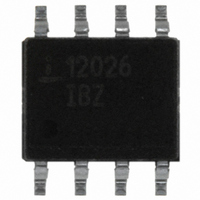ISL12026IBZ Intersil, ISL12026IBZ Datasheet - Page 13

ISL12026IBZ
Manufacturer Part Number
ISL12026IBZ
Description
IC RTC/CALENDAR EEPROM 8-SOIC
Manufacturer
Intersil
Type
Clock/Calendar/EEPROMr
Specifications of ISL12026IBZ
Memory Size
4K (512 x 8)
Time Format
HH:MM:SS (12/24 hr)
Date Format
YY-MM-DD-dd
Interface
I²C, 2-Wire Serial
Voltage - Supply
2.7 V ~ 5.5 V
Operating Temperature
-40°C ~ 85°C
Mounting Type
Surface Mount
Package / Case
8-SOIC (3.9mm Width)
Clock Format
HH
Clock Ic Type
RTC
Interface Type
I2C, Serial
Memory Configuration
512 X 8
Supply Voltage Range
2.7V To 5.5V
Digital Ic Case Style
SOIC
Rohs Compliant
Yes
Lead Free Status / RoHS Status
Lead free / RoHS Compliant
Available stocks
Company
Part Number
Manufacturer
Quantity
Price
Company:
Part Number:
ISL12026IBZ
Manufacturer:
INTELSEL
Quantity:
60
Part Number:
ISL12026IBZ
Manufacturer:
INTERSIL
Quantity:
20 000
Part Number:
ISL12026IBZ-T
Manufacturer:
INTERSIL
Quantity:
20 000
Writing to the Alarm Registers
The Alarm Registers are non-volatile but require special
attention to insure a proper non-volatile write takes place.
Specifically, byte writes to individual registers are good for all
but registers 0006h and 0000Eh, which are the DWA0 and
DWA1 registers, respectively. Those registers will require a
special page write for nonvolatile storage. The
recommended page write sequences are as follows:
1. 16-byte page writes: The best way to write or update the
2. Other nonvolatile writes: It is possible to do writes of
and AL1E bits are set to "1", then both AL0E and AL1E
PIM alarms will function. The IRQ/F
be pulsed each time each of the alarms occurs. This
means that once the interrupt mode alarm is set, it will
continue to alarm for each occurring match of the alarm
and present time. This mode is convenient for hourly or
daily hardware interrupts in microcontroller applications
such as security cameras or utility meter reading.
Interrupt Mode CANNOT be used for general periodic
alarms, however, since a specific time period cannot be
programmed for interrupt, only matches to a specific time
of day. The interrupt mode is only stopped by disabling
the IM bit or the Alarm Enable bits.
Alarm Registers is to perform a 16-byte write beginning at
address 0001h (MNA0) and wrapping around and ending
at address 0000h (SCA0). This will insure that non-
volatile storage takes place. This means that the code
must be designed so that the Alarm0 data is written
starting with Minutes register, and then all the Alarm1
data, with the last byte being the Alarm0 Seconds (the
page ends at the Alarm1 Y2k register and then wraps
around to address 0000h).
Alternatively, the 16-byte page write could start with
address 0009h, wrap around and finish with address
0008h. Note that any page write ending at address
0007h or 000Fh (the highest byte in each Alarm) will not
trigger a nonvolatile write, so wrapping around or
overlapping to the following Alarm's Seconds register is
advised.
less than an entire page, but the final byte must always
be addresses 0000h through 0004h or 0008h though
000Ch to trigger a nonvolatile write. Writing to those
blocks of 5 bytes sequentially, or individually, will trigger a
nonvolatile write. If the DWA0 or DWA1 registers need to
be set, then enough bytes will need to be written to
overlap with the other Alarm register and trigger the
nonvolatile write. For Example, if the DWA0 register is
being set, then the code can start with a multiple byte
write beginning at address 0006h, and then write 3 bytes
ending with the SCA1 register as follows:
Addr
0006h DWA0
0007h Y2K0
0008h SCA1
Name
13
OUT
output will now
ISL12026
If the Alarm1 is used, SCA1 would need to have the correct
data written.
Power Control Operation
The power control circuit accepts a V
Many types of batteries can be used with Intersil RTC
products. For example, 3.0V or 3.6V Lithium batteries are
appropriate, and battery sizes are available that can power
an Intersil RTC device for up to 10 years. Another option is
to use a SuperCap for applications where V
for up to a month. See the Applications Section for more
information.
There are two options for setting the change-over conditions
from V
register controls this operation.
Note that the I
battery backup, that function is controlled by the SBIB bit.
That operation is covered after the power control section.
OPTION 1- STANDARD POWER CONTROL MODE
In the Standard mode, the supply will switch over to the
battery when V
lower. In this mode, accidental operation from the battery is
prevented since the battery backup input will only be used
when the V
To select Option 1, BSW bit in the Power Register must be
set to “BSW = 0”. A description of power switchover follows
Standard Mode Power Switchover
• Normal Operating Mode (V
To transition from the V
following conditions must be met:
• Battery Backup Mode (V
The ISL12026ISL12026 device will switch from the V
V
There are two discrete situations that are possible when
using Standard Mode: V
DD
- Option 1 - Standard Mode
- Option 2 - Legacy Mode (Default)
(V
- Condition 1:
- Condition 2:
- Condition 1:
- Condition 2:
BAT
V
where V
V
where V
V
where V
V
where V
mode when one of the following conditions occurs:
DD
DD
DD
DD
DD
)
< V
< V
> V
> V
to Battery back-up mode. The BSW bit in the PWR
DD
BATHYS
TRIP
BATHYS
TRIPHYS
BAT
TRIP
BAT
TRIP
2
DD
supply is shut off.
C bus may or may not be operational during
- V
+ V
≈ 2.2V
+ V
drops below V
BATHYS
BATHYS
≈ 50mV
≈ 50mV
TRIPHYS
≈ 30mV
DD
BAT
to V
BAT
< V
DD
) to Normal Mode (V
BAT
TRIP
) to Battery Backup Mode
TRIP
mode, both of the
DD
and V
or V
and a V
BAT
BAT
DD
, whichever is
is interrupted
>V
BAT
October 23, 2006
DD
TRIP
input.
BAT
)
FN8231.5
.
to












